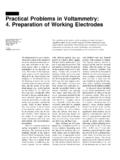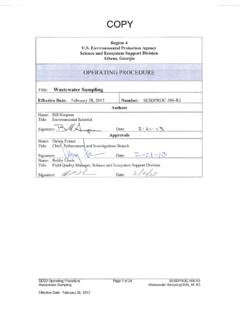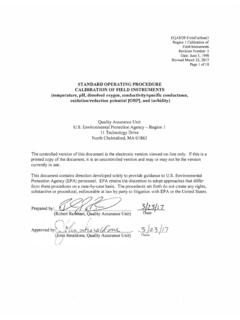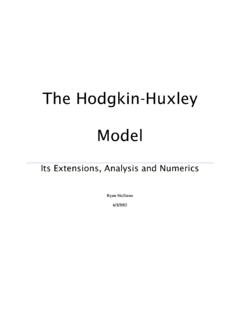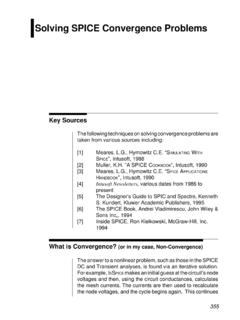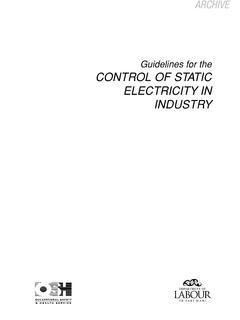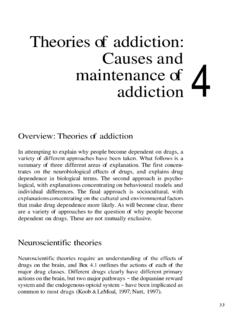Transcription of Conductance Measurements Part 1:Theory
1 A Review of ParametersDescribing ElectrolyteSolutionsWhen two electrodes are immersedin a solution and a potential is ap-plied across them, a current will beproduced in the external circuit thatconnects the two electrodes. Themechanism of electrical communi-cation between the two electrodes insolution is the movement of ions inthe solution. When no appreciablesolution electrolysis occurs, themagnitude of the current observedgenerally obeys Ohm s Law:E=iREQ1whereEis the applied potential,iisthe current measured, andRis theresistance of the solution betweenthe two ResistanceIt is the quantityR(in one formor another) that is of interest in thepresent discussion. The higher theconcentration of ions present in thesolution, the lowerRwill be.
2 Osten-sibly molecularly pure water has apH value of 7 and hence contains1 10-7 Molar OH-ions as well as1 10-7 Molar H+ions (the latter pre-sent in the form of H3O+,H5O2+,..).If a strong electrolyte ( , fully dis-sociable salt) like KCl is dissolved inwater, the number of ions per unitvolume increases and the solutionresistanceRis lowered, thus increas-ing the instantaneous current meas-ured for a particular appliedpotential. Therefore, current can berelated to the concentration of ionsin a particular solution. However, thedistance between the electrodes, thesurface area of the electrodes, andthe identity of the ions also ConductanceThe reciprocal of solution resis-tance is calledconductance, symbol-ized by the letterS(orL). Conductance is expressed in calledsiemens(Sor -1), al-though older literature may refer toan equivalent unit called themho( -1).
3 As discussed above in the con-text of resistance, the measured con-ductance for a solution is related tothe distance between the electrodes(d) and the microscopic surface area(geometric area roughness factor)of each electrode (A; assumed iden-tical for the two electrodes), as wellas the ionic concentration. These pa-rameters are interrelated by (1):ConductivityThe quantity , above, is calledconductivityand it contains all of thechemical information available fromthe measurement ( , concentra-tions and mobilities of the ions pre-sent). The ratiod/Ais a constant fora particular measurement cell, and ishence referred to as thecell constant, (2). Therefore, =S EQ3 The conductivity, , is an intrinsicproperty of a solution, rather than aConductance MeasurementsPart 1: TheoryMeasurement of solution Conductance is a classical electroanalytical techniquethat finds application in a variety of chemical and biochemical studies.
4 Forexample, Conductance can be used to assess solvent purity, determine relativeionic strengths of solutions (including functioning as a detector for ionchromatography), monitor dissolution kinetics and the approach to equilibriumfor partially soluble salts, determine critical micelle concentrations, follow thecourse of some enzymatic reactions, as well as to provide basic thermodynamicdata for electrolyte solutions. The first installment in this two-part articlereviews the basic physicochemical concepts underlying ionic conductivity insolution and discusses the principles of two different approaches to thedetermination of Conductance . Part 2 will present experimental details ofconductance Measurements and discuss a few representative applications ofconductance Measurements in chemical Coury, Systems, Kent AvenueWest Lafayette, = 1 RAdEQ291 Current Separations 18:3 (1999)property of the Conductance cellused.
5 However, for detection pur-poses in liquid chromatography or indetermination of equivalence pointsduring titrations, only relativechanges are of interest (rather thanabsolute values); hence, the conduc-tance,S, maybe be reported insteadof .MobilityIt is important to realize that con-ductance (and conductivity) valuescontain more information than sim-ple ion concentrations. That is, themeasured conductivity for a solutionof 1 Molar HCl will be substantiallydifferent than for 1 Molar KCl. Thisfact arises because protons are muchmore mobile in solution than potas-sium ions. Such differences may bequantified by considering the pa-rameter called themobility(u)ofanion. The mobility is essentially thatpart of the conductivity that is inde-pendent of concentration.
6 In an idealcase, the mobility of an ion i de-pends on the charge on the ion (zi),its solvated radius (Ri), the viscosityof the solvent ( ) and the elementarycharge constant (e) according to (3):Conductivity and ConcentrationThe experimentally determinedconductivity reflects contributionsfrom all ions present in solution thatare mobile and can support the cur-rent. Conductivity can be written interms of the mobilities of all of theions present (3):whereFis the Faraday constant(96,485 C/mol), andCiis the con-centration of ion i in mol/cm3. Thesignificance ofEQ5is that it showsthat conductivity reflects the identity(charge and mobility) of all ions pre-sent in solution, as well as their con-centrations. This is the principle thatputs conductivity Measurements inthe realm of analytical chemistry,since there is a linear relationshipbetween a measurable quantity ( )and ConductivitySince conductivity is concentra-tion dependent, measured values fordifferent solutions are not easy tocompare directly.
7 For this reason, aquantity called themolar conductiv-ity(or sometimesequivalent con-ductivity) is used (2,3). The molarconductivity is symbolized by ,and it is defined as the solution con-ductivity ( ) normalized by the totalionic concentration (C):In this context, total ionic con-centration means Molar concentra-tion of positive charges (or negativecharges) in solution, expressed inunits of vs. Weak ElectrolytesIn an ideal case, the molar con-ductivity experimentally determinedfor a compound would be the same,regardless of the actual concentra-tion of the solution used for themeasurement. For example, al-though the values of for solutionsprepared to be Molar and in KCl would be different, should be the same in each case,since has effectively been normal-ized for the difference in concentra-tions.
8 In practice, however, mostcompounds that dissolve in waterand undergo ionization behave dif-ferently in highly dilute solutionscompared to even moderately con-centrated solutions (3). Compoundsthat exhibit molar conductivities thatdo not change significantly with con-centration are referred to asstrongelectrolytes, and include salts such asKCl. Other compounds such as ace-tic acid are nearly completely ion-ized at low concentrations, but areincompletely ionized at higher con-centrations. This class of compoundsis known asweak data (3) for KCl and ace-tic acid are plotted inF1to illustratethe severity of this Molar ConductivityFor comparison of conductivi-ties of dissimilar compounds, themost useful quantity to consider isthelimiting molar conductivity, parameter represents the molarconductivity for a compound thatwould hypothetically be measured inthe limit of infinite dilution ( , they-axis intercepts of plots like thoseinF1).
9 In practice, such values areobtained by fitting experimental datatoanequationknownasKohlrausch s Law(3):The coefficientKdepends pri-marily on the type of the electrolyte( , 1:1 or MA, 2:1 or M2A, etc.),rather than its specific chemicalidentity (3). In any event, experimen-tal values of have been carefullydetermined for many salts as a func-tion of concentration in very dilutesolutions, and the intercept values ofthe resulting plots obtained. In ex-amining such data, it was discoveredF1A plot of concentration conductivitymeasured for a typicalstrong electrolyte (KCl)and for a weak electrolyte(CH3 COOH). (Adaptedfrom reference 3.) (Molar) (S-cm /mol) zie 6 RiEQ4 =F z u C FzCiiiii= zie 6 Riii((EQ5 = CEQ6 = 0 KCEQ7 Current Separations 18:3 (1999)92that 0for any electrolyte can beexpressed as the sum of independentcontributions from the constituentcations and anions present.))
10 This factis now known asKohlrausch s Lawof the Independent Migration of Ions(3): 0= + 0++ - 0-EQ8 InEQ8, +and -representstoichiometric coefficients for thecation and anion in the electrolyte,respectively. For example, forK4Fe(CN)6, += 4 and -= 1, sincethere are 4 K+ions present for eachFe(CN)64-ion present in Ionic MolarConductivitiesNext, we must consider themeaning of the quantities denoted by 0+and 0-inEQ8. These quantitiesare known aslimiting ionic molarconductivities, since they representthe contributions to the total solutionconductivity made per mole of eachion present in a dilute solution. It isthese 0values that are tabulated inreference books such as the CRCH andbook of Chemistry and Physics(4) and text books (2,3). Values for afew common ions are shown data presented are for a tempera-ture of 25 C, and are limiting ionicmolarconductivities, as opposed tothe limiting ionicequivalentconduc-tivities reported elsewhere (3).


